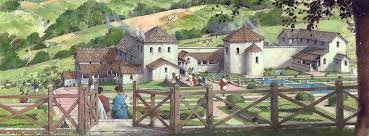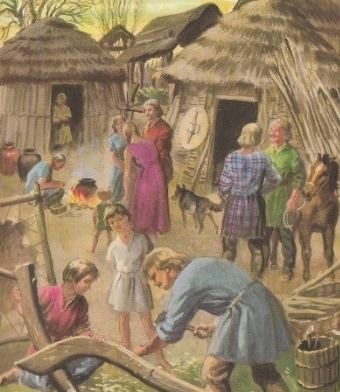… Suffice to say that garum, a humble fishy condiment, helps us to understand and humanise these economic processes, from the lives of fishers and their boats and nets to the free and enslaved workers who processed the fish – all the way through the supply chain across water and land, to far flung borders like Hadrian’s Wall …
Read moreNorton Disney Roman Villa Landscape 2021 - A New Threat
Source: English Heritage, Roman Villa in Britain Reconstruction
I’m not the only person to have noted that the new planning application for Villa Farm Norton Disney does not differ in any meaningful way from the previous unsuccessful application. Given that the statutory authorities, if the system works as it should, are duty bound to reject this latest application, it begs the questions why the developers bothered to do it?
And this is the question that bugs me.
Read moreMuseums, Children and Violent Images - Boudicca in Colchester
Panel showing destruction of Temple of Claudius, Colchester Castle Museum
How do you present things to children like the ‘Boudiccan revolt’ and the massacres of colonists that took place at Colchester and London in AD 60 – and can it ever be got right? Given we have two written accounts (by Tacitus and, later, Cassius Dio), can we ignore them? Dio pulled no punches in recounting hideous atrocities being carried out on Roman citizen women – their breasts were cut off and sewn to their mouths, and their bodies skewered lengthways – but are these images ‘suitable’ for children?
And already - see? - the subject is fetishised. But remove those accounts, and knowledge and images of annihilation and casualties on all 'sides', and the subject becomes sanitised.
Read moreThe 'Gods of Old' at Norton Disney - and the Power of Community Archaeology
Pavement at 'Potter Hill villa', Norton Disney, excavations c 1934. Photo kindly supplied by David Barker, archivist of the Collingham & District Local History Society. An already-damaged Roman building undergoes a somewhat shoddy excavation in the 1930s.
The objections poured in thick and fast. Many objected to the poor quality of the planning application, which seems to be claiming that two huge buildings, associated traffic and commercial activities, and an enormous chimney, would have 'no adverse impact' on this ecologically beautiful, archaeologically-rich locale. Then there was the lack of an obvious map (at least whenever I looked), and the somewhat desultory list of consultees. It was, to my eyes, as an archaeologist and a former Planning Committee member, all pretty woeful. And, sadly, the archaeological desk-top survey included with the application was incomplete, based on inadequate data, and quite eyebrow-raising in its brevity.
Read morePolyandry in Late Iron Age and Roman Britain - Myth or Reality?
Couldn't resist this Ladybird book image of Julius Caesar's Britain ... so who's married to who?
It's been a while since anyone took much notice of Julius Caesar's writings on ancient Britain as any kind of credible social commentary. There's not only the problem that he was writing for a particular audience and in a particular style - there's also the issue that so little of what he says about Britain matches the archaeological evidence.
But that's not to say that his words aren't worth looking at. His statements about (at least some) British marriages tantalise us with their allusions not just to polygamous unions but to a rare form of this known as 'polyandry' - the marriage of a woman to more than one man - as well as to how the children of these marriages were made legitimate.
Read moreWhat is a Roman Villa?
Idyllic image of Great Witcombe Roman villa (Credit: Historic England)
What was a ‘villa’ to the Roman eye and to the Roman understanding? What do modern archaeologists need to see on the ground in order to classify a site as a ‘villa’? In what ways - if at all - are they a meaningful category of evidence, and how might they give us information about the Roman economy and the colonisation of landscapes by idealised edifices? On some sites in early Roman Britain, within just a couple of decades of the occupation and in the vicinity of new Roman towns, the traditional late Iron Age settlement type of timber roundhouses were replaced by a Roman building type of rectangular houses with stone foundations and, seemingly, increased room divisions. What does this all mean - what class of habitus are we dealing with here?
Read moreThree Burials at Norton Disney - and the End of Roman Villas in Britain
Late burial from Norton Disney Roman villa (Oswald 1937)
In the 1930s, three intriguing burials were found by Adrian Oswald and his workforce in the upper archaeological levels at Norton Disney Roman villa. Some might call these inhumations strange, lying as they did not in a burial ground but on top of or aligned with dismantled walls of once-imposing buildings from the Roman era. Why are they there? How rare are such burials? What can they tell us about life and death and the end of Roman villas in Britain - and indeed the end of Roman Britain itself?
Read moreThe Intriguing Roman Villa at Norton Disney – A Conundrum under a Threat
Norton Disney late burial - Oswald 1937 (see Refs)
I’m deliberately keeping this piece as short as possible – a lot of people involved already have too many stacks of papers on their desks and in their inboxes. This is a ‘capsule argument’ about how and why this site at Norton Disney matters, and why it deserves protection. It’s one of many villas known, but it’s one of the most intriguing. It was partly excavated a couple of years prior to World War II, so is ‘known about’; but those excavations by Adrian Oswald have themselves thrown up a whole range of puzzles. These include the archaeological narratives currently emerging of connections that stretch from prehistoric tribal Ireland through to this corner of Lincolnshire, and the story of the rise of private property and the collapse of Roman Britain - as well as suspicions of an excavator 'dining out' on fabricated stories of Saxon raiders and collisions of races and nations in the late 1930s.
Read moreWriting Roman Britain in 1,200 Words - aka, Writing for Encyclopedias
'How would you like to do a small job?' asked Martin Millett. 'It's paid,' he added helpfully. (Doesn't that say something about archaeology, when it's a bonus to be paid for one's labours.) I asked what it was, and he said it was a simple writing job for a new encyclopedia on British History. They wanted some stuff on Roman Britain and, if I had the time, it would be right up my street.
Oh that sounds great, I said. So Martin put me in touch with the editor, Professor John Cannon, and forward we went on our great word-restricted, tightly-written adventure. Fifty quid a thousand words and a free copy of the finished weighty tome, The Oxford Companion to British History. I was on my first maternity leave - what could possibly go wrong?
Read more






